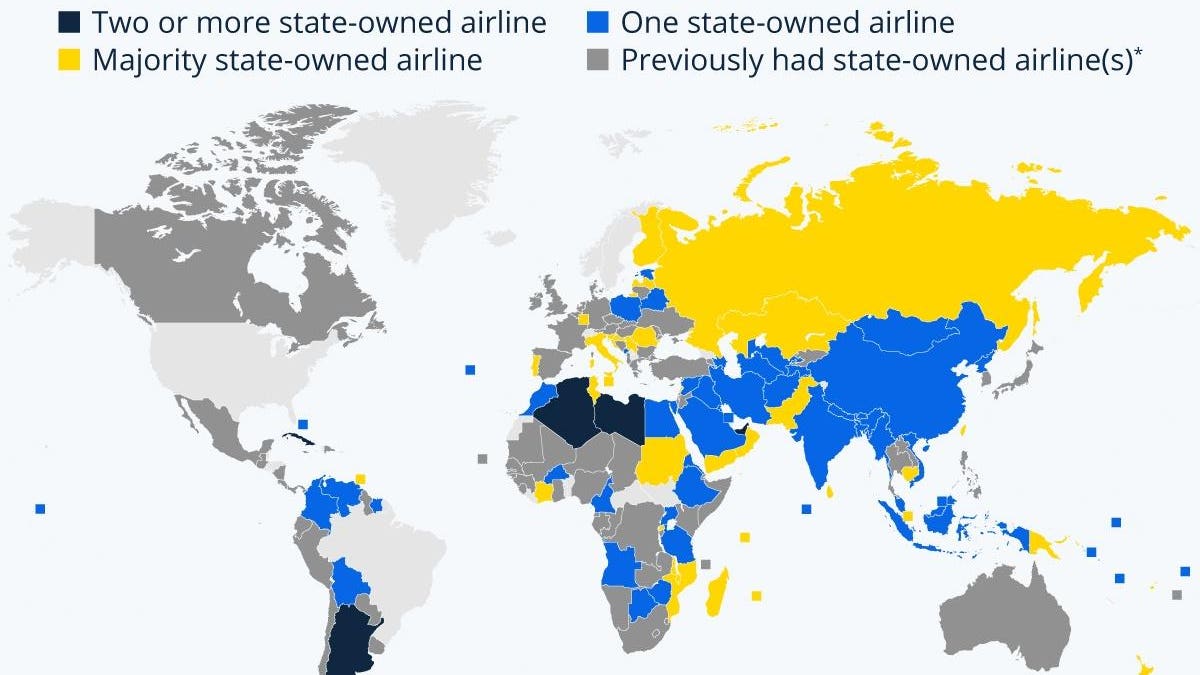In a move that some might describe as unexpected, Mexican President Andrés Manuel López Obrador announced the creation of a new state-owned airline last week, which will be run by the country’s army. With a launch as early as September, the carrier will focus on domestic routes, expanding on López Obrador’s vision of reviving state-owned enterprises with the help of the nation’s armed forces.
While new state-owned airlines are certainly a novelty, legacy national carriers that remain fully or majority-owned by governments are far from a rarity worldwide. A Statista analysis of International Civil Aviation Organization data and media reports shows that there are still around 100 such airlines in existence around the world today.
Enlisting the armed forces, for example the army or the air force, to run a state-owned airline has a long history in Latin America and has often reflected the idea of offering affordable flights even in remote locations. Argentina, Cuba and Colombia still own such airlines, albeit on rather small and regional levels, and they also used to exist in Ecuador, Paraguay and Peru.
As of August 2023, state-owned airlines were most common in the Middle East and North Africa as well as in Asia. Meanwhile, many African state-owned airlines have been sold or gone bust.
A look at the map also shows that state-owned airlines used to be a global phenomenon as the quick rise of aviation around the middle of the last century, its global reach and cosmopolitan image piqued the interest of national governments. Apart from airlines being seen as a good way to bolster one’s image at home and abroad, governments in the early days of the airline industry also played a more obvious role, as previous to the deregulation of the market, they had a say in who could service air routes from and to their country.
The United States stands out as the only major country that has never had a state-owned airline. Neither did Brazil, but the country is a special case where a carrier founded by a regional government, VASP of São Paulo, rose to national prominence with a focus on domestic routes.
Not one but several national airlines
Countries where more than one state-owned airline still operate are Algeria, Argentina, Cuba, Libya and the United Arab Emirates, which holds the record at three carriers in the hands of state. Technically, these airlines are owned by the Dubai and Abu Dhabi governments, two out of the seven sheikdoms that make up the UAE
UAE
This is also most typically the job given to the army—like in the strategy Mexico is pursuing now. However, the new carrier is to be named Mexicana, after the country’s defunct national airline Mexicana de Aviación—showing that nostalgia and national pride remain connected to carriers that have historically represented countries and their governments.
Another state actor that has been running national airlines is oil or energy companies, which have traditionally provided workers with air lifts but also maintained scheduled services. One of Algeria’s two state-owned airlines falls into this category. Former secondary state-owned airlines in Angola and Kazakhstan operated under the same scheme.
Comeback of the state-owned carrier?
While a few countries, including Cambodia, Uganda, Estonia and Montenegro, have recently revived state-owned airlines, others have (temporarily) come into ownership again after bailouts, for example the Czech Republic and Italy. Yet again others have tried to unload unwanted airlines onto the market but failed to find a buyer—like Poland and Malaysia.
For many countries, especially in Europe, a state-owned airline is only a distant memory, with legacy carriers like KLM, British Airways and Air France having been privatized between the 1980s and early 2000s. However, in all of the three countries associated with these carriers, state-owned airlines are still taking off—if just on a regional level. The governments of French islands Corse and French Polynesia majority-own one airline each, while the regional administrations in the UK’s Guernsey and Cayman Islands wholly own theirs. In the Dutch Sint Maarten, government-owned Winair is still taking off. Similar schemes exist in the Danish Faroe Islands, Greenland, Japan’s Southern island of Kyushu and among Canada’s remote First Nations, highlighting that the need for government-organized air travel persists in some locations.
—
Charted by Statista
Read the full article here





